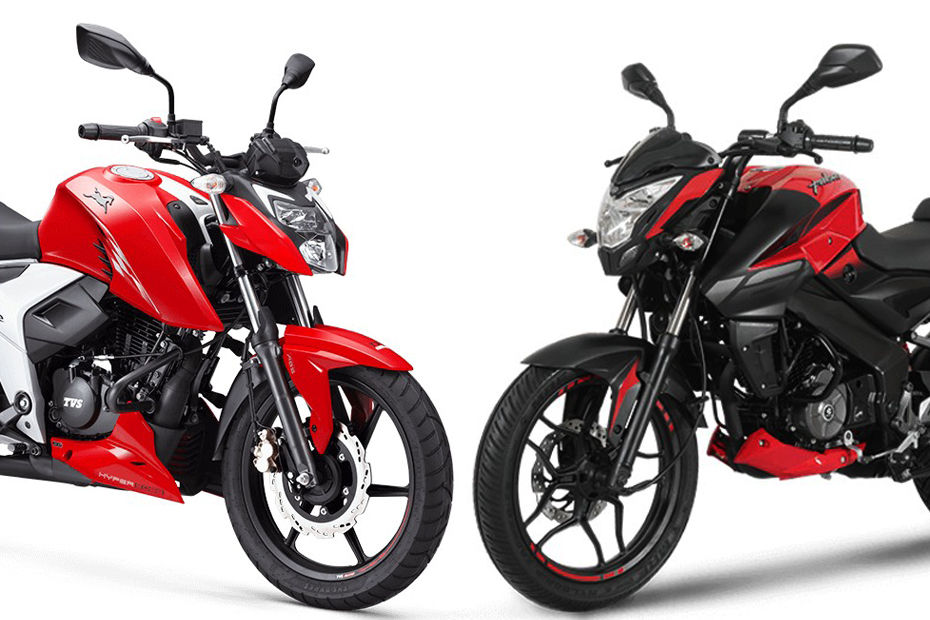Bajaj Pulsar NS160 BS6 vs TVS Apache RTR 160 4V BS6: Spec Comparison
Modified On Apr 22, 2020 08:36 PM By Gaurav Sadanand for Bajaj Pulsar NS160
- 6273 Views
- Write a comment
Two entry-level performance-oriented commuters that now comply with BS6 emission norms. But which one has the upper hand on paper?

The Bajaj Pulsar NS160 and TVS RTR 160 4V were introduced as budget-friendly performance-oriented commuters for enthusiasts in India. These bikes come equipped with a potent 160cc engine that offers thrilling performance while complying with BS6 emission norms. While one gains more performance, the other offers better features. But which one is a better bet on paper?
Engine:

Both bikes run shoulder-to-shoulder in terms of displacement, engine configuration, and technology. However, Bajaj has managed to extract more power from the 160.3cc mill with the BS6 update. The motor, which once made 15.5PS, has been retuned to deliver 17.2PS (1.7?PS more than the BS4 model). This also puts the NS160 ahead of the RTR 160 4V, which was once the benchmark in the segment.
Also Read: BS6 TVS Apache RTR 160 4V, Apache RTR 200 4V: First Ride Review

Torque outputs are near-identical as well, with the RTR 160 gaining a slight edge over the NS160 on paper. But the RTR is 2kgs lighter than the NS160, which means, it should be just a little bit quicker to bolt off the line. That said, the NS160’s power advantage means it’s sure to catch up fairly quickly and zip past the RTR with the help of an extra cog.
Underpinnings:

Granted, the perimeter frame on the NS160 is more advanced on paper than the double-cradle frame on the RTR 160 4V. But that isn’t necessarily the case in the real world.

Both bikes feature the same suspension setup, however, the one on the RTR has been tuned by Showa for better balance. Another plus for the RTR 160 is its braking setup. The larger surface area on its petal discs provides better heat dissipation, which is needed to maintain brake feel and responsiveness during extended use.
The wider tyres on the RTR imply it’ll have a better contact patch and offer more stability at high speeds compared to the NS.
Dimensions:

TVS’ learnings from the race track are pretty evident in the RTR’s packaging. It features a shorter wheelbase compared to the NS160, which should make it a slightly better handler than the NS. It also has more room underneath (180mm), which should keep it clear of tall speed breakers. However, at 177mm, the NS160 is unlikely to face any problems either.

The 12-litre fuel tank paired with the fuel-injected engines on either bike should return a decent fuel-efficiency -- more than enough for your daily commutes. At 151kg, the NS maybe a tad difficult to move around the parking lot or zip through city traffic. The lighter RTR, on the other hand, maybe a bit easier as it weighs 2kg less.
Features:

This is where the RTR 160 4V comes into its own. TVS offers a bunch of features with the BS6 model including a full-digital instrument console with readouts such as a lap timer, 0-60 timer, and top speed recorder. It also gets Glide Through Traffic, which lets the engine maintain certain speeds in city traffic by making use of the engine torque. And, there’s no need to keep yanking on the clutch. TVS goes an extra mile to offer a stickier rear Pirelli tyre as an option, which could improve the bike’s riding dynamics.
While the NS200 may look wooden compared to the RTR160, its styling is still amongst the best in the segment. The new paint schemes that were added with the last update also give it some added flair. No wonder there’s still a huge demand for the NS series.
Price & Verdict:
(all prices ex-showroom, Delhi)

The price difference between the NS160 and the RTR 160 4V is just Rs 600! So it basically boils down to your requirements. If you’re looking for outright power and the aggressive Pulsar styling, the NS160 is the way to go. That said, the RTR 160 4V offers more bang for the buck with its feature-packed instrument console, full-LED headlight, Glide Through Technology, and optional rear Pirelli tyre.
